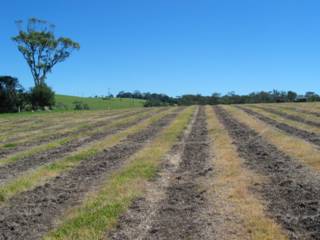Of the 72ha (180acres), 4ha (10acres) will be initially set aside for grapes. There will be four separate blocks in various parts of the property to take advantage of the best aspect, slope, soil and microclimate for grape growing.
The varieties selected include Semillon, Sauvignon Blanc, Voignier, Verdelho, Arneis, Cabernet Franc and Gamay.
The first step in developing a vineyard, after site selection, is deciding on row length, spacing, and orientation as well as headland dimensions and positioning of access roads and drainage systems. Then it is a matter of marking out the rows, spraying off the grass cover with a herbicide and cultivating by ripping, discing and rotary hoeing.

Cultivated Rows
This is also the time that the soil can be ameliorated (eg. lime) and nutrients (N, P, K etc.) added according to the results of previous soil tests. Generally a pre-emergent herbicide is incorporated in the prepared soil during the last of these operations. This prevents weeds competing with the new vines for nutrients and moisture. Then the end assemblies for the trellises are installed along with the intermediate posts. This involves accurate marking then mechanically driving the posts a minimum of a metre (3ft) into the ground.

"Sharpened" End Posts Ready for Driving
The end assemblies have to take quite a deal of strain once the wires are installed and tightened and the grapevines are growing on them. There are many designs of end assemblies that perform successfully. In our case, wooden end posts of a larger diameter than the intermediate posts have been used and are supported by a strut that is chocked by the first intermediate post in the row. 
Driving the Posts
A properly designed and installed end post reduces the instance of breakage and pull out. CCA treated pine posts have been selected for this vineyard. They are strong as well as being rot and termite resistant. 
Completed End Assemblies
We have become involved with planting. At a row spacing of 2.2m and a vine spacing of 1.2m, this involves a total of approximately 15000 vines for the vineyard. The new vines are delivered as one-year-old bare rooted rootlings that have been kept in cold storage to prevent them shooting or banded vines which are already growing in degradable pots. The former have to be removed from cold storage and hydrated for 24 hours before planting while the latter is gradually exposed to their new environment on delivery and kept well watered.
In the vineyard, the position of each individual vine has to be marked ie. at the correct spacing directly under where the cordon wire will eventually be. This is done with a line and a spray can of marking paint. Then a hole is dug at a spade’s width and depth.
The rootling or a banded vine is placed in the hole, covered with soil and firmed down.

Planting
The final step in the process is watering. This will settle the earth around the roots and prevent them from drying out. Each new vine should receive 3-5L. We have found that a team of one marker (who becomes a planter/waterer after that job is finished), two diggers, one planter and one waterer can get around 600 vines into the ground in a day.
15000 divided by 600 equals……………….. too much work to contemplate.

Watering
It’s hot work under the blazing summer sun but there is a sense of achievement when at the end of the day you look back along the rows at the “sticks” that will eventually burst into leaf and grow into the walls of green. And you get to touch up your suntan as well.




















No comments:
Post a Comment